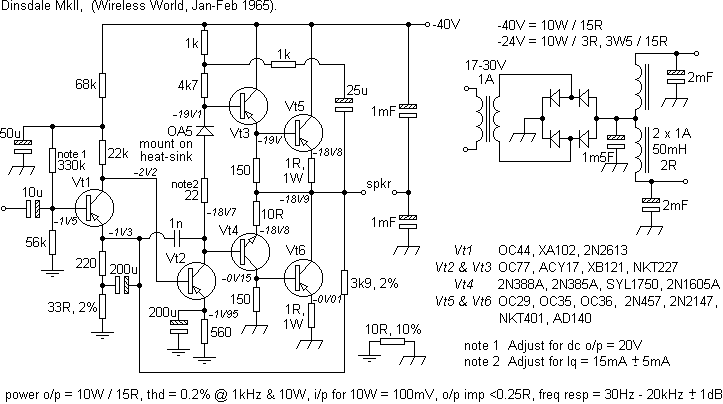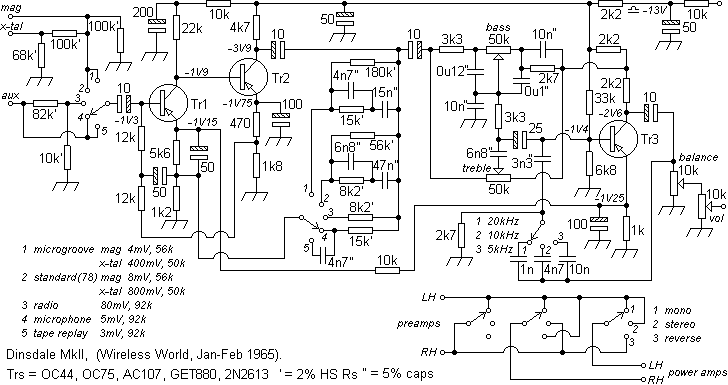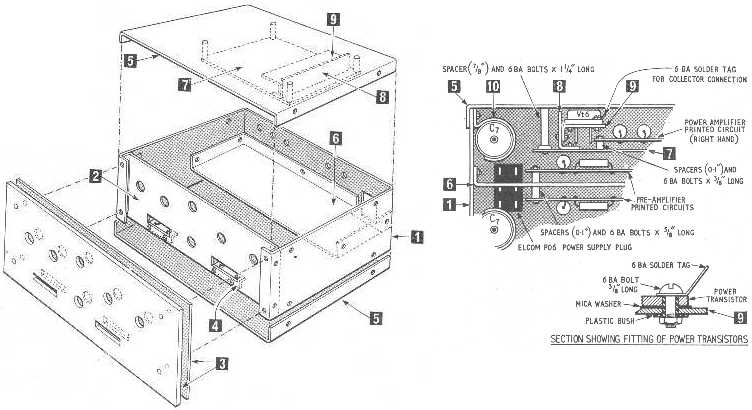
Dinsdale MkIIFollowing up a transformerless approach first ventured in late 1961 (Wireless World, Tobey and Dinsdale), with a preamp capable of handling the then new magnetic cartridges for microgroove as well as 78 rpm records, this design covered most problems encountered with integrated stereo designs and, importantly, included portable operation.

Ballasting the bootstrap capacitor with a 1k resistor helped prevent 'bottoming' of Vt3 with large negative-going signals. Loading the earth loop, within the main feedback loop where no large voltage amplifications take place, continues to be used to this day, although an alternative arrangement was given in the reprint - the 10R resistor can be removed and separate earth runs be made from both the earlier stages of the amplifiers and their output stages direct to the + terminal of the 1m5F smoother. Dinsdale suggested an 8-way connecting socket to accommodate the extra wires (author's note: the paralleling of high and low current earth runs can give rise to instabilities due to induction by high magnetic flux densities).Providing an artificial AC centre tap for the output was intended to prevent potentially destructive switch-on transients caused by the output capacitor charging through the load. This unfortunately increased the number of invariably unreliable large capacitors from say three to seven. A quasi-complementary output stage eases output device selection and reduces costs, it being easier and cheaper to produce PNP devices in germanium, and later, NPN in silicon which could run hotter. A drawback encountered with this arrangement is that the transfer characteristic can become markedly assymetrical at low signal levels, then contributing to distortion.
The qualities of early magnetic cartridges were limited and performance varied between batches, not only in respect of frequency response but with crosstalk too, notably through variations in inductance. To put the technology into perspective, the designer found that using a Decca "ffss" MkI cartridge with a Decca SXL 2057 test record produced a channel difference of only 6dB @ 2kHz when only one channel contained recorded information. This approach addressed the problem by using a high input impedance (100k).

A dual log/antilog balance control preceding the volume control reduced losses to 10% at the mid-point, compared to 50% with linear controls. A switchable low-pass filter and a useful function switch added versatility. Although equalisation is provided for a tape head (CCIR 7½ips), notable is the absence of an output for a tape recorder. Input connections were made with (Belling Lee L604/S) 75-ohm co-axial plugs and sockets and the power supply was separate, a radiogram type housing being anticipated, and/or use with batteries.
Noise for the entire system is given as -70dB (controls level) though the designer did report that this could be improved upon, with a noise variability of 50dB between transistors from the same packet, to some -85dB. Overall negative feedback from Tr3's emitter provides stability at low frequencies.Unfortunately, photographs of the prototype included in the original article did not reproduce well. However, two diagrams are given below to demonstrate the layout.

The front panel measuring 10.5 x 4.5" and the remaining enclosure 9.625 x 7.5 x 3.625", some 17 separate parts made of 18swg aluminium or duralumin had to be made up. The separate preamp PCBs were mounted on the central partition and the PA PCBs on the upper and lower lids. Mains (or battery) wiring to a switch on the volume control was brought in via the power supply plug. Discussion was given to the excessive wear the volume control would then suffer, although it was noted that with this at it's minimum position on switch-on, transients would be reduced.Despite the lower operating temperature, some germanium designs have offered much in the way of lifespan. A 40-year-old+ Philips music centre continues to work well, apart from dirty switches, and the author feeds a silicon output stage from a tuner amp whose Ge output transistors are still functional and on occasion used.
There is more than a passing resemblance between this design and that adopted by Leak for solid-state designs which were manufactured up until 1978, some seventeen years later.
Contact me at paulkemble@hotmail.com
especially if you want additional content to this page
or if you find any links that don't work. Don't forget
to add the page title or URL. Take care!
Back to index, sound, tips or home.